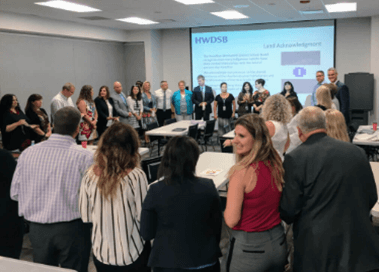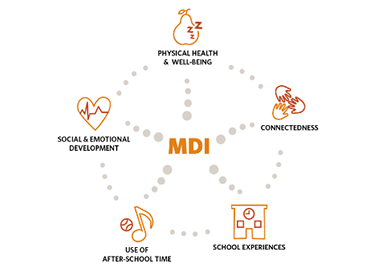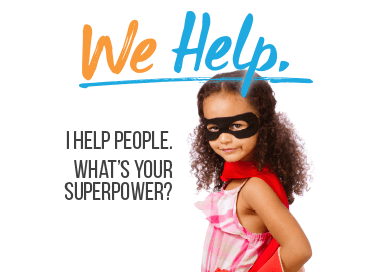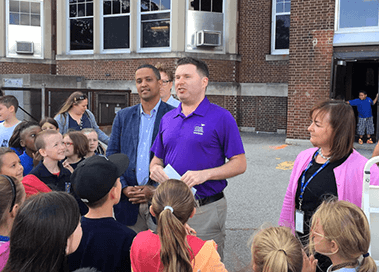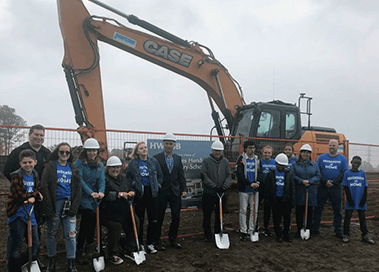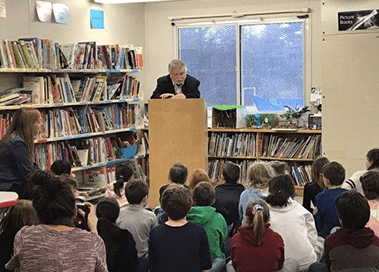
 The 2017-18 school year was an exciting time at HWDSB, as we continued to refine and deliver on the HWDSB Reimagined vision developed with community input. we continued to deliver on the promise of our new priorities: Positive Culture and Well-being, Student Learning and Achievement, Effective Communication, School Renewal and Partnerships.
The 2017-18 school year was an exciting time at HWDSB, as we continued to refine and deliver on the HWDSB Reimagined vision developed with community input. we continued to deliver on the promise of our new priorities: Positive Culture and Well-being, Student Learning and Achievement, Effective Communication, School Renewal and Partnerships.
Let me underline one of our commitments for special attention, equity. If a theme runs through our work at HWDSB in this report, it is our commitment to our High Priority Schools, the embrace of equity throughout the organization and supporting racialized and marginalized communities so they feel safe, supported and accepted in our schools.
On a personal level, looking back on the past year reminds me of my own journey to visit the concentration camp at Auschwitz, as well as Israel. My eyes were opened to the reality of ethnic hatred – specifically anti-Semitic hatred – and the seriousness with which we must fight against intolerance.
Please find a summary of our work in 2017-18, as we moved toward our goals, adjusted course and developed our Board Annual Plan for 2018-19. These are the ways we help curiosity, creativity and possibility come alive for our students, staff and community.

Positive Culture and Well-Being
We will build student and staff well-being through positive climate strategies and supportive relationships.
Progress in 2017-18
Goal All HWDSB students and staff feel safe, supported and accepted.
Target: Every school and department will improve the number of staff and students feeling safe, supported and accepted by August 2017.
Strategy: Communities use site specific data from the Positive Culture and Staff Voice Surveys to create their School or Service Department Annual Plans. HWDSB piloted the Middle Years Development Instrument (MDI) in all grades 4 to 8 classrooms, to gather data on health, connectedness and school experiences and respond in ways that reduce inequity and improve educational opportunities for elementary students. The Secondary Positive Climate Survey revealed that students report less bullying, increased feelings of safety and an increased belief that helps exists at school, as well as indicating more work to do on equity and inclusion. On our Staff Voice Survey, High Priority Schools showed an improved culture and smaller gap to non-High Priority Schools.
Strategy: Continue to engage System Leaders in equity and inclusive professional learning. Service Leaders continued Deep Diversity learning to set the foundation for our 2018-19 Staff Census. Leaders also reviewed and reflected on the provincial Equity Action Plan, which led to a Trustee-approved hiring of a Human Rights and Equity Officer to work across departments within HWDSB. Administrators were gifted a replica Wampum Belt as a tool for learning and responding to the Truth and Reconciliation Commission Calls to Action.
Strategy: Review and implement the Mental Health Strategy. Aligning our work with the province, we launched We Help as the brand for Positive Culture and Well-being across all schools and departments, with a focus on creating climates that foster help-seeking and help-providing behaviors. We build capacity on suicide prevention, school attendance and mentally healthy classrooms. We implemented mental health programming and planning, including for specific populations such as LGBTQI2S+ and racialized youth. And we enhanced system coordination by aligning social work and mental health, as well as new structures for community input.
Strategy: Intensive focus on positive culture and well-being in high priority schools. Superintendents of Student Achievement visited these schools with a greater frequency to learn more about their needs and monitor progress. Staff monitored and assessed differences in High Priority Schools using the Staff Voice Survey, a comparative analysis of the MDI, and a comparative analysis of the School Conditions Survey. We were pleased to see High Priority Schools progress on surveys related to positive culture and well-being. At the time of the related Board report, staff had not meet the target to have every school and department improve the number of staff and students feeling safe, supported and accepted by August 2018.
Action Plan for 2018-19
Goal: All students and staff feel, safe, supported and accepted.
Target #1: The number of students who feel safe, supported and accepted will increase by June 2020.
Strategy: Provide professional learning for staff on how to use student survey data, and anti-racism and anti-oppression strategies. School administrators will review school-level student and staff well-being data to identify strengths, surprises and next steps regarding the Positive Culture and Well-being priority of the School Annual Plan. Service Leaders will review system and department staff well-being data, within the context of department plans. Considering learning from Deep Diversity training and student voice, leaders will learn about using an anti-racism/anti-oppression framework for decision making and action. We expect this will positively impact relationships and climate.
Strategy: Leverage effective practices in schools that enhance student-staff relationships, including a focus on students identifying a caring adult, through the mental health strategy, We Help. We will support school administrators to set targets and use the continuous learning and improvement process, with a focus on positive culture and well-being. Schools will apply strategies from the We Help mental well-being initiative to enhance student-staff relationships. We will review approaches to bullying and other behaviours and develop tools to measure improved relationships.
Strategy: Implement the next phase of the High Priority Schools plans. Building on year one, we will look at the best fit when assigning school administrators, as we continue to make positive culture and well-being a focus in school plans. To provide resources where needed most, we will assign Early Child Development Support Educators to High Priority Schools among other services and resources. We will learn about identifying and removing barriers to success at high priority schools and enhance our focus on partnerships which support nutrition programs. At the time of the related Board report, staff were on target to have the number of students who feel safe, supported and accepted increase by June 2020.
Target #2: The number of staff feeling safe, supported and accepted will increase by June 2020.
Strategy: Provide professional learning on anti-racism and anti-oppression strategies. Like System Leaders, Service Leaders will learn about using an anti-racism/anti-oppression framework for decision making and action in departments. We expect this will improve relationships.
Strategy: Develop and implement a staff census to understand the diversity of our employee community. To understand staff diversity and how we reflect our community, staff will work with union leaders to develop the HWDSB Staff Census. This builds on diversity learning, will launch in spring 2019 and will be the only system survey of 2018-19.
Strategy: Develop and implement a strategic wellness and absence management plan. We will redefine this program to detail responsibility, training and HWDSB support for absent employees. We expect this will help staff attend work regularly and give supervisors guidance to support staff during the process. At the time of the related Board report, staff were on target to have the number of staff who feel safe, supported and accepted increase by June 2020.
Student Learning and Achievement
We are committed to improving student learning and achievement through effective instructional strategies.
Progress in 2017-18
Goal #1: All students reading by the end of Grade 1.
Target: At least 75 per cent of Grade 1 students achieving a B (provincial standard or higher on their June 2018 report card).
Strategy: Review and implement the Early Reading Strategy. HWDSB developed an Early Reading Strategy that builds deep understanding of the components of reading, how these components are developed, and the roles staff have in supporting early reading. We introduced Reading Specialists at all schools with Kindergarten and Grade 1 classes, to support reading acquisition and to respond to student learning needs. We monitored student progress using a new digital tool tracking phonological awareness in eight pilot schools, as well as superintendent visits. Overall, the percentage of Grade 1 students earning a B on the June 2018 Report Card increased 5 per cent from June 2017.
Strategy: Intensive focus on early reading in High Priority Schools. We supported High Priority Schools through increased resources including Reading Specialists, a kindergarten teacher and a Designated Early Childhood Educator in each kindergarten classroom and more frequent superintendent visits. We learned more about the value of principal leadership of early reading and consistent tools, language and marking in literacy. The percentage of Grade 1 students in High Priority Schools earning a B in reading on the June 2018 Report Card increased by 8 per cent from June 2017.
Strategy: Implement effective comprehensive literacy practices and interventions through the continuous learning and improvement process. Teachers in grades 2 to 8 employed a comprehensive literacy program that provides modelled, shared, guided, and independent learning experiences in reading and writing. Dozens of educators enhanced their learning through reading AQ courses. Engagement increased for students involved in the Forest of Reading Red Maple Program, a partnership partially funded by the Hamilton Community Foundation’s ABACUS Program that provides high-interest texts. At the time of the related Board report, staff were not on target to have at least 75% of Grade 1 students achieving a B (provincial standard) or higher on their June 2018 report card. 66% of Grade 1 students achieved a B or higher.
Goal #2: Improvement in Mathematics.
Target: At least 65 per cent of students achieving at or above provincial standard as measured by 2017-18 EQAO (total number of students in primary, junior and Grade 9).
Strategy: Review and implement the Renewed Math Strategy (RMS). Educators developed a greater understanding of knowing students’ learning needs, how to improve this with instruction, as well as the importance of having students understand numbers deeply and for basic operations. Math Facilitators worked in schools that the Ministry of Education has termed “intense need” in mathematics. High schools focused on learning how to better support students in applied Grade 9 and 10 math. Grade 3 EQAO Math scores rose two percentage points to 50 per cent of students at provincial standard in 2017-18 from 2016-17 and the gap with the province narrowed by 3 percentage points.
Strategy: Intensive focus on mathematics in High Priority Schools. We deployed Math Facilitators in schools with intense or increased needs, to help implement the math strategy, deliver purposeful instruction and address and meet student needs. We learned from schools that math learning can be supported through a calm and structured classroom, and math facilitators needed more frequent contact with staff and students. High Priority Schools narrowed the gap with the province.
Strategy: Implement effective comprehensive mathematics practices and interventions through the continuous learning and improvement process. Within this process for our math strategy, principals and vice-principals led their staff identify learning needs, enhance and assess instruction to meet learning needs, and reflect on learning for planning next steps. Professional activity days and staff meetings engaged staff in continuous learning and improvement focused on math. Superintendents monitored progress through school visits among other inputs. At the time of the related Board report, staff were not on target to have at least 65 per cent of Grade 3, Grade 6, Grade 9 students achieve at the provincial standard or higher in 2018 with 49 per cent of students reaching the provincial standard.
Goal #3: All Students Graduating
Target: At least 83 per cent of the 2013-14 cohort (staying in HWDSB) will graduate within five years (by August 2018).
Strategy: Refine our measures of students’ progress towards graduation over time. Our Student Information Strategy led to two digital tools connected to school information, for school leaders: PowerBi enabled Principals and Vice-Principals to access student achievement data and to monitor student achievement, and Enterprise Reporting enables the user to select a variety of data into a report for analysis. This helped us use data more intentionally to identify, intervene, and track student progress towards graduation.
Strategy: Identify, monitor and provide differentiated support for in-risk students. Secondary schools monitored students struggling with academics, well-being and attendance for targeted in-school and system supports. We hired a system Early Leaver Teacher to re-engage students who had left secondary school without graduating and were able to re-engage 53 students. Re-engagement comes in many forms, including a John Howard Society partnership, programming for Indigenous or expecting students, and those more comfortable with e-learning than in-class learning. HWDSB schools improved their performance on the Ontario Secondary School Literacy Test by 1 percentage point to 74 per cent in 2017-18, which narrows the gap with the province.
Strategy: Implement effective instructional practices and interventions through the continuous learning and improvement process. The 7-12 Literacy Gap Closing Initiative’s cross-panel teams focused on helping students develop ideas in writing, a gap on OSSLT tests. The CLIA grades 9 and 10 math initiative worked through a plan, act, assess, and reflect process to improve student performance in applied Grade 9 and 10 math. We also worked to close gaps with a Literacy Facilitator supporting literacy strategies on the OSSLT, Empower teachers providing credit-granting literacy instruction for students reading below Grade 9. Staff met the 2016-17 annual plan target of 82 per cent graduation rate for the 2012-13 cohort. At the time of the related Board report, staff were not on target to have at least 83 per cent of the 2013-2014 cohort (staying in HWDSB) graduate within five years (by August 2018).
Action Plan for 2018-19
Goal #1: All students reading.
Target: At least 75 per cent of Grade 1 students achieving at or above provincial standard on their June report card.
Strategy: Provide professional learning on comprehensive literacy instruction, assessment and interventions for Reading Specialists, Kindergarten and Grade 1 educators. We will focus on developing resources to explain the Early Reading Strategy, role of Reading Specialists and determining a B in Grade 1 reading, so that we have a common understanding, vocabulary, and standard for instruction and assessment for early reading across the HWDSB. We will communicate our strategy, with professional learning for reading specialists on effective instruction, for classroom teachers and DECEs on instruction and assessment, and administrators on monitoring and supporting learning. We will collect data on the quality of this learning, and long-term impact on instruction, to monitor progress.
Strategy: Leverage effective literacy practices in classrooms including a dedicated daily focus on reading. In Grade 1 classrooms, teachers will provide a daily comprehensive literacy program consisting of a variety of rich learning experiences, aimed at developing proficient readers and writers. Kindergarten educators will build reading and writing opportunities from play-based learning, engaging the students. In a primary classroom, 100 uninterrupted minutes of comprehensive literacy should occur daily. In each, educators should assess student learning using effective tools and then plan future learning experiences and supports based on student learning.
Strategy: Refine the measures used to monitor the progress students make towards becoming effective readers by the end of Grade 1. The Program Division is developing a “milestone” tool that outlines the indicators of developmentally appropriate reading acquisition, drawing on the phonological screener, Development Reading Assessment and Ontario curriculum document for Grade 1. This tool will help educators track progress, identify who needs support and set learning goals.
Strategy: Implement the next phase of the High Priority Schools plan. Enhanced supports for High Priority Schools include full-time Reading Specialists in each HPS school, DECEs in each HPS Kindergarten classroom and a 26-student cap in Kindergarten classrooms. We will also pilot in five HPS schools a new professional learning strategy, the Purposeful Triad Meeting, that looks at one student’s progress closely to focus next steps for other students. At the time of the related Board report, staff were on-track to have at least 75 per cent of Grade 1 students achieving a B (provincial standard) or higher on their June 2019 report card.
Goal #2: Improvement in Mathematics.
Target: The gap between HWDSB and the province for those students performing at or above the provincial standard on the junior (Grade 6) EQAO math assessment will be narrowed by June 2020.
Strategy: Investing in People. Provide professional learning on comprehensive math instruction, assessment and interventions for grades 4 through 6 educators. Building on the 2017-18 HWDSB Renewed Math Strategy, the Program Division will focus its efforts in 2018-19 on supporting classroom teachers, Principals, and Vice-Principals. This will include implementing the newly released Focusing on the Fundamentals of Mathematics resource that focuses on core skills such as working with numbers, applying number properties and mental math skills. This will also include deepening teacher understanding of the math curriculum, using the online HWDSB resource Learning Math Together and a Specialized Services pilot supporting grades 4 to 6 students with learning disabilities.
Strategy: Leveraging effective Practices. Leverage effective math practices in classrooms including a focus on fundamental concepts and skills. The 2018-19 HWDSB Math Strategy focuses on supporting students in the acquisition of fundamental math strategies within a comprehensive math program. Comprehensive math strategies refer to teaching practices that provide modelled, shared, guided, and independent opportunities for students to learn and practice math knowledge and skills. The strategy’s goal is to have students show that they understand numbers and how they behave, can recall math facts, can do mental math and can calculate operations.
Strategy: Refining measures of Progress. Refine the measures used to monitor the progress students make towards understanding math concepts by the end of Grade 6. Creating a continuum, aligned to the Ontario curriculum and five fundamental math skills, will help monitor student progress and tailor supports for missing skills. We will explore digitizing this continuum so that data analysis can identify patterns. At the time of the related Board report, staff were on track to narrow the gap between HWDSB and the province for those students performing at or above the provincial standard on the junior (Grade 6) EQAO math assessment by June 2020.
Goal #3: All students graduating.
Target: At least 83 per cent of students will graduate within five years, by August 2020.
Strategy: Investing in People: Provide professional learning on student success strategies for grades 7 through 12 educators with an emphasis on applied-level math. Staff will build on the professional learning provided in previous years to close achievement gaps for students in grades 7 to 12. We will place a special focus on supports for Applied Math students, cross-panel supports for closing the literacy gap and an enhanced understanding of the diverse programs available in secondary schools (co-op, e-learning, SHSMs, etc.).
Strategy: Leverage effective student success practices in schools including a focus on approaches for students in-risk of not graduating. We will review student success strategies to engage secondary staff in reflecting on their current practices, identifying any gaps in their practice and, piloting innovative practices for in-risk students. Key work will include using data, having a caring adult for at least each student in Grade 9 Applied Math, re-engaging early leavers, learning options and more.
Strategy: Refine the measures used to monitor the progress students make towards graduation. We will continue to implement PowerBi and Enterprise Reporting as digital tools for monitoring student progress towards graduation. As well, superintendents will continue to track credit attainment, community hours, and OSSLT status for year four and five secondary students. We will track students in-risk of not graduating and identify the intervention for that student. At the time of the related Board report, staff were on-track to have at least 83 per cent of students graduate within five years, by August 2020
 |
 |
 |
| Student Achievement Focus Yields Results at High Priority Schools | Throat-singing, carving and Arctic char: HWDSB students heading to Arctic Circle | The Expansion of eLearning at HWDSB |
Effective Communication
We are committed to improving our communication through comprehensive strategies.
Progress in 2017-18
Goal: Improve internal and external communications.
Target: Implement a research-based strategic communication and engagement plan based on the recommendations of the communication audit.
Note that 2017-18 year was a year of transition to restructure and develop the strategic and communication plan.
Strategy: Restructure the roles and responsibilities of the Communications and Community Engagement Team to align work with the Board’s five Reimagined priorities. A focus on roles and responsibilities for the Communications and Community Engagement team was a priority during the first year of the newly formed department. In addition to several opportunities to engage the department in the process, the mandate, roles and responsibilities as well as the code of ethics for the department were part of the discussions during the Strategic Communications and Engagement Plan ad hoc committee.
Strategy: Review and systemically implement communication systems. With an aim to improve internal communications, this strategy was pursued through a Leadership and Staff Ambassador focus. Our Leadership focus supports HWDSB in building trust, navigating challenge, and creating positive environments (with parent groups) that value open and two-way communications. We also began to invest in a staff ambassadors program to engage staff, help them access information and create a culture of communications.
Strategy: Develop and implement an integrated digital engagement strategy. This includes multiple strategies, tactics, processes, tools and technologies to structurally engage parents and staff. Digital engagement is about understanding our audience through the various platforms, keeping them engaged and telling our stories. At the time of the related Board report, staff had not meet the target to implement a research-based strategic communication and engagement plan based on the recommendations of the communications audit.
Action Plan for 2018-19
Goal: Improve internal and external communications.
Target: Implement year one of the 2018-2021 Strategic Communications and Engagement Plan.
Strategy: Mobilize knowledge for staff through a new intranet and staff directory. Establish an interdepartmental team to understand the platform and deliver the implementation of the new intranet Dedicate a staff person to work through the structures/communication pathways to employee announcements and input the data to create an accessible staff directory.
Strategy: Standardize digital platforms to improve communication with staff, parents and students. Establish an interdepartmental team to prepare a productivity and digital platforms report.
Strategy: Implement the Parent Portal for parents, guardians and caregivers in all schools. The Parent Portal at the secondary level has been deployed. An awareness campaign will be conducted in the fall for Secondary parents. The Parent Portal at the elementary level is projected to be launched in March, dependent on the unified classroom rollout in February. At the time of the related Board report, staff were on target to implement year one of the 2018-2021 Strategic Communications and Engagement Plan.
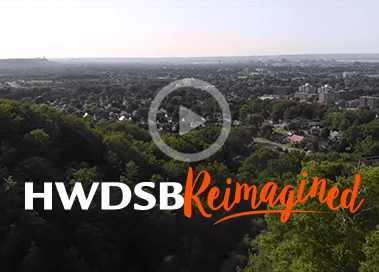 |
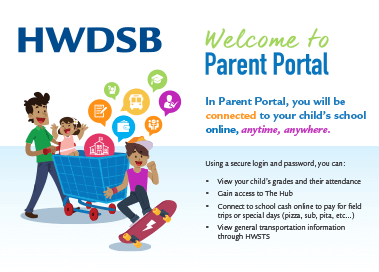 |
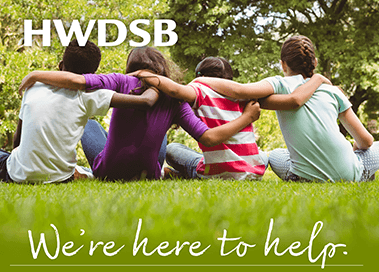 |
| #HWDSBReimagined Relaunches our Vision | Platforms, Stories, Citizenship and Feedback: HWDSB Communications Embraces Digital Engagement | How HWDSB Schools Embraced Mental Health Week |
School Renewal
We are committed to optimizing opportunities to invest in improved school facilities.
Progress in 2017-18
Goal: Improve the conditions of our schools
Target: At least 25 per cent fewer schools will be identified as being in poor condition by 2020.
Strategy: Implement the annual capital plan included in the Long-Term Facilities Master Plan which includes elementary and secondary facility benchmarks, school renewal and repairs and maintenance. Our Long-Term Facilities Master Plan identifies funding in these areas, which includes:
- $11 million for Secondary Facility Benchmarks (5 years)
- $2 million for Secondary Program Strategy (5 years)
- $10 million for Elementary Facility Benchmarks (8 years)
- $1 million for Elementary Program Strategy (5 years)
- $8 million for School Renewal (plus the additional renewal money provided by the Ministry)
- $3.5 million of Operating Budget for Repairs and Maintenance.
Strategy: Ensure all new school builds, additions and renovations meet the facility benchmarks established by the Board. In addition to the projects mentioned above, in 2017-18 the Board received funding for new schools at Memorial Stoney Creek, the Glen Campus and C.H. Bray, as well as for additions at Collegiate and Ancaster Senior. Board staff ensured that all new builds meet the facility benchmarks established by the Board.
Strategy: Work with municipal partners to ensure that the Board can proceed with the capital projects for which funding has already been received. Staff and Trustees continued to work with city staff and councillors to ensure that the Board receives approvals as quickly as possible. This includes regular meetings between the Board and City staff, meetings with Trustees and Councillors regarding specific projects and identifying and keeping the City up to date on capital projects being undertaken by the Board at the City-Board Liaison Committee meetings.
Strategy: Maximize funding received from Ministry capital funding opportunities. On May 29, 2017 and June 5, 2017, the Board approved the Ancaster and West Hamilton City accommodation review recommendations. The recommendations included three new elementary schools and one addition. On July 15, 2017, the Board submitted these business cases and one new school, and the addition were approved. Staff will continue to submit business cases where applicable. At the time of the related Board report, staff were on target to have at least 25 per cent fewer schools in poor condition by 2020.
Action Plan for 2018-19
Goal: Improve the conditions of our schools.
Target: At least 25 per cent fewer schools will be identified as being in poor condition by 2020.
Strategy: Implement the annual capital plan included in the Long-Term Facilities Master Plan, which includes elementary and secondary facility benchmarks, school renewal, repairs and maintenance.
Strategy: Work with municipal partners to ensure that the Board can proceed with the capital projects for which funding has already been received.
Strategy: Maximize funding received through Ministry of Education capital funding opportunities.
This report has not yet come to Board.
Partnerships
We are committed to strengthening our collaboration with new and existing community partners to enhance opportunities for students.
Progress in 2017-18
Goal #1: All parents, guardians, caregivers and families are welcome, respected and valued as partners in student learning, achievement and well-being.
Target: At least 75 per cent of parents, guardians and caregivers indicate that they have an awareness of what their children are learning in their classrooms by June 2018.
Strategy: Educators use a variety of approaches to communicate classroom learning to parents/guardians/caregivers. Our Parent Voice Survey collected input from families about what we do well and what we can improve, with a focus on partnerships and home-school connections. We developed online training modules on bylaws, communications, fundraising and more, to support principals and School Council members in their role. We embedded parent engagement in school annual plans, refined materials supporting families around kindergarten and math, and piloted the Safe Arrival automated attendance system.
Strategy: Enhanced focus on families to support high priority schools. With the municipality, we made plans to offer before- and after-school programming in all High Priority Schools for the 2018-19 school year. The HWDSB Foundation ensured that about 155 year one kindergarten children at HPS schools receive a book a month to support early literacy, through Imagination Library. The three-week summer camp, Camp POWER, began revision to focus on early reading alongside intensive parent engagement at HPS schools. At the time of the related Board report, staff were not on target to reach at least 75 per cent of parents who indicated that they have an awareness of what their child is learning in their classroom, by June 2018. (Our Parent Voice Survey is administered every two years.)
Goal #2: We will strengthen our collaboration with new and existing community partners to enhance opportunities for students.
Target: Increase equity of access in community partnerships supporting our two priorities of student learning and achievement and positive culture and well-being by June 2018.
Strategy: Launch and use a database to track, analyze and communicate effective school and system partnerships. We began to populate our new partnership database to help us better understand, leverage and identify gaps around mutually beneficial collaborative relationships that support student achievement and well-being. The database requires regular maintenance. School administrators will be introduced to the tool in 2018-19.
Strategy: Enhance focus of community partnerships to support high priority schools. Staff adapted Professor Ken Leithwood’s Strong Districts rubric for a tool to look at characteristics and school conditions in High Priority Schools, with partnerships one of the variables. We worked closely with Public Health this year to plan for new Public Health Nurse support model in schools, augmenting their traditional roles with a more visible presence in schools supporting positive culture and well-being. At the time of the related Board report, staff were on target to increase equity of access in community partnerships supporting our two priorities of Student Learning and Achievement and Positive Culture and Well-Being by June 2018.
Action Plan for 2018-19
Goal: All new and existing community partnerships will enhance opportunities for students.
Target: Establish a baseline of community partnerships that support student outcomes.
Strategy: Collect and analyze partnership data for the system and High Priority Schools.
Strategy: Align community partners’ goals with student needs in High Priority Schools.
This report has not yet come to Board.
 |
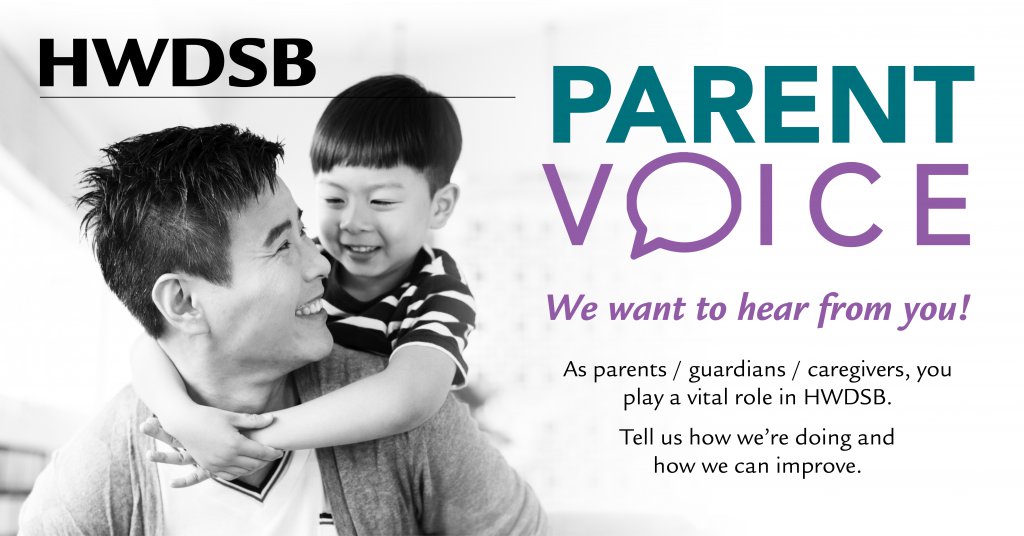 |
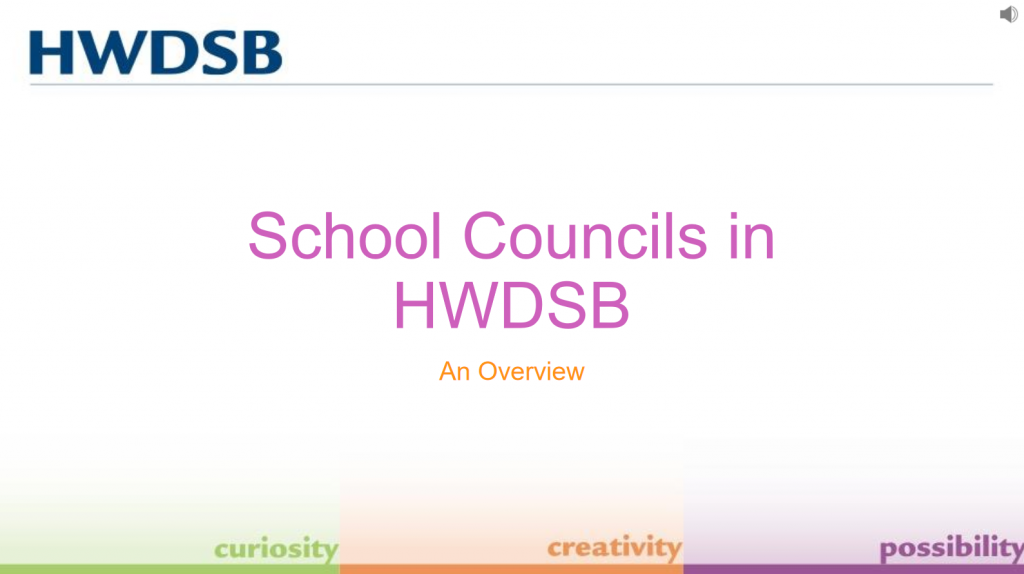 |
| Kindergarten Registration Now Open at HWDSB | HWDSB Launches Parent Voice Survey to Gather Input for Improvement | School Council 101: Our Supports for School Councils |
Updated on Friday, December 13, 2019.


